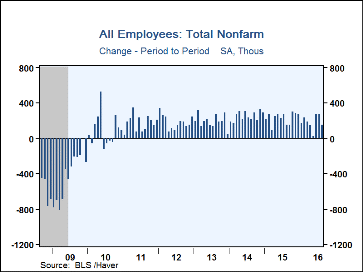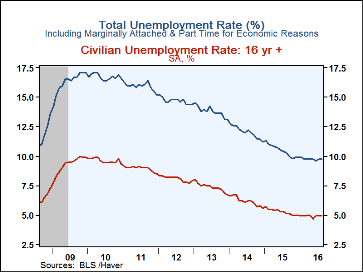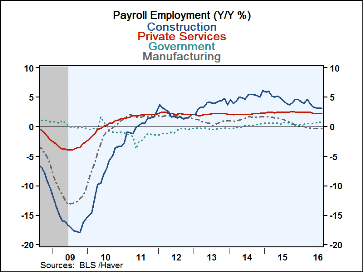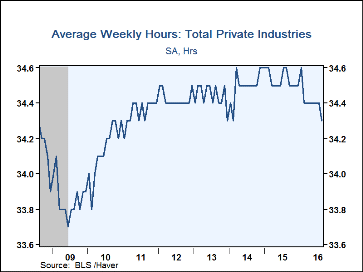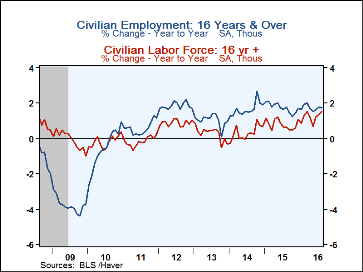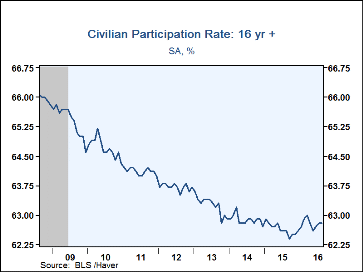 Global| Sep 02 2016
Global| Sep 02 2016U.S. Payroll Increase Weakens Significantly
by:Tom Moeller
|in:Economy in Brief
Summary
Earlier strength in the job market subsided last month. Nonfarm payroll employment increased 151,000 (1.7% y/y) during August. That followed an upwardly revised 275,000 July rise, but June's gain was lessened to 271,000. A 180,000 [...]
Earlier strength in the job market subsided last month. Nonfarm payroll employment increased 151,000 (1.7% y/y) during August. That followed an upwardly revised 275,000 July rise, but June's gain was lessened to 271,000. A 180,000 increase had been expected in the Action Economics Forecast Survey. So far this year, payroll employment increases averaged 182,000 per month versus 229,000 averaged last year and 251,000 in 2014. Job market gains waned across sectors last month. The unemployment rate held steady at 4.9%, where it's been for three months. Expectations were for a dip to 4.8%. The total unemployment rate, including those marginally attached or working part time for economic reasons, held steady at 9.7%. Average hourly earnings ticked 0.1% higher (2.4% y/y); a 0.2% rise was expected.
From the payroll employment survey, the 151,000 job increase was the weakest in three months. It reflected declines throughout the goods-producing sector. Factory sector jobs declined 14,000 (-0.3% y/), the first decline in three months. Construction sector employment eased 6,000 (+3.1% y/y), the fourth decline in five months. Mining sector hiring eased 4,300 (-6.1% y/y), and has been falling since Q4'14.
Private service sector employment improved 150,000 (2.2% y/y). So far this year monthly gains averaged 170,000 versus 205,000 last year. Education & health services jobs grew 39,000 (2.8% y/y), the weakest rise since January. Trade, transportation & utility employment improved 34,000 (1.5% y/y), including a fairly steady 15,100 rise (1.9% y/y) in retail jobs. Leisure & hospitality jobs grew 29,000 (2.8% y/y), equaling the average so far this year. Professional & business services hiring improved 22,000 in August (2.7% y/y), down from 47,000 averaged in the prior six months. Temporary help employment declined 3,100 (+1.2% y/y), the first fall in three months. Jobs in financial activities improved 15,000 (2.0% y/y), also near this year's average. Information sector employment improved 4,000 (1.1% y/y), about as it has this year. Government sector jobs improved 25,000 (0.7% y/y). Local government jobs grew 24,000 (0.8% y/y), but state level jobs were unchanged (0.3% y/y). Federal government jobs edged 1,000 higher (1.3% y/y).
The length of the average workweek shortened to 34.3 hours, and has been falling since January's high of 34.6 hours. Hours-worked in mining & logging were significantly reduced at 42.8, versus 44.8 averaged during all of 2014. The factory sector workweek eased to 40.6 hours, and has been roughly stable since early last year. The construction sector workweek dropped sharply to 38.7 hours, as did hours in the private service-producing sector to 33.2. Hours in trade, transportation & utilities fell sharply to 34.2 versus last year's high of 34.7. Information sector hours of 35.9 compare to 36.8 at their 2014 peak. Hours in the financial sector have been fairly steady at 37.5. Hours-worked in leisure & hospitality fell sharply to 26.0 versus last year's peak of 26.4.
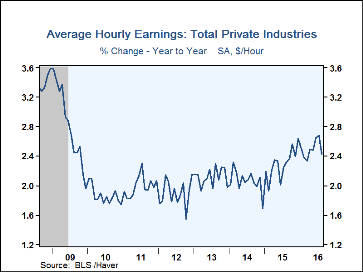 Average hourly earnings edged 0.1% higher. That left
the y/y increase of 2.4% up from the 1.9% low during all of 2012. Earnings
were little changed m/m throughout the goods-producing sector. In
services, the 0.2% rise (2.5% y/y) was paced by a 0.5% increase (4.3% y/y)
in the information sector. Leisure & hospitality earnings gained 0.2%
(3.9% y/y). Financial sector earnings grew 0.2% (2.8% y/y) while education
& health services pay ticked up 0.1% (1.5% y/y).
Average hourly earnings edged 0.1% higher. That left
the y/y increase of 2.4% up from the 1.9% low during all of 2012. Earnings
were little changed m/m throughout the goods-producing sector. In
services, the 0.2% rise (2.5% y/y) was paced by a 0.5% increase (4.3% y/y)
in the information sector. Leisure & hospitality earnings gained 0.2%
(3.9% y/y). Financial sector earnings grew 0.2% (2.8% y/y) while education
& health services pay ticked up 0.1% (1.5% y/y).
From the household employment survey, the stable 4.9% unemployment rate reflected a 97,000 rise (1.7% y/y) in employment and a 176,000 gain (1.5% y/y) in the labor force. The labor force participation rate held steady at 62.8%, up from last year's low of 62.4%. The participation rate amongst men aged 20 & over held steady at 71.7%, while for women aged 20 & over it remained at 58.3%. The average duration of unemployment fell to 27.6 weeks from 39.4 weeks averaged in both 2011 and 2012.
The teenage unemployment rate eased to 15.6%, down from its 2010 high of 27.2%. Unemployment amongst those aged 20-24 of 9.0% was below the 2010 high of 15.9%. For individuals aged 25 & over, unemployment averaged 4.0%, more than half its 2009 high.
By educational attainment, those with less than a high school diploma realized a sharply reduced jobless rate of 6.3%. High school graduates with no college realized 5.0% unemployment. Those with some college, but no degree were 4.3% unemployed while college graduates realized 2.5% unemployment.
The labor market data are contained in Haver's USECON database. Detailed figures are in the EMPL and LABOR databases. The expectations figure is in the AS1REPNA database.
| Employment: (SA, M/M Change, 000s) | Aug | Jul | Jun | Aug Y/Y | 2015 | 2014 | 2013 |
|---|---|---|---|---|---|---|---|
| Payroll Employment | 151 | 275 | 271 | 1.7 | 2.1% | 1.9% | 1.6% |
| Previous | -- | 255 | 292 | -- | -- | -- | -- |
| Manufacturing | -14 | 6 | 8 | -0.3 | 1.1 | 1.4 | 0.8 |
| Construction | -6 | 11 | -6 | 3.1 | 4.8 | 5.0 | 3.7 |
| Private Service-Producing | 150 | 214 | 243 | 2.2 | 2.5 | 2.1 | 2.1 |
| Government | 25 | 50 | 33 | 0.7 | 0.5 | 0.0 | -0.3 |
| Average Weekly Hours - Private Sector | 34.3 | 34.4 | 34.4 | 34.6 | 34.5 | 34.5 | 34.5 |
| Private Sector Average Hourly Earnings (%) | 0.1 | 0.3 | 0.1 | 2.4 | 2.3 | 2.1 | 2.1 |
| Unemployment Rate (%) | 4.9 | 4.9 | 4.9 | 5.1 | 5.3 | 6.2 | 7.4 |
Tom Moeller
AuthorMore in Author Profile »Prior to joining Haver Analytics in 2000, Mr. Moeller worked as the Economist at Chancellor Capital Management from 1985 to 1999. There, he developed comprehensive economic forecasts and interpreted economic data for equity and fixed income portfolio managers. Also at Chancellor, Mr. Moeller worked as an equity analyst and was responsible for researching and rating companies in the economically sensitive automobile and housing industries for investment in Chancellor’s equity portfolio. Prior to joining Chancellor, Mr. Moeller was an Economist at Citibank from 1979 to 1984. He also analyzed pricing behavior in the metals industry for the Council on Wage and Price Stability in Washington, D.C. In 1999, Mr. Moeller received the award for most accurate forecast from the Forecasters' Club of New York. From 1990 to 1992 he was President of the New York Association for Business Economists. Mr. Moeller earned an M.B.A. in Finance from Fordham University, where he graduated in 1987. He holds a Bachelor of Arts in Economics from George Washington University.


